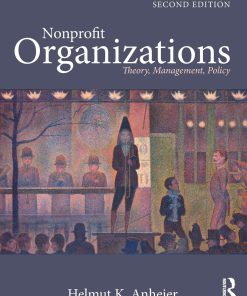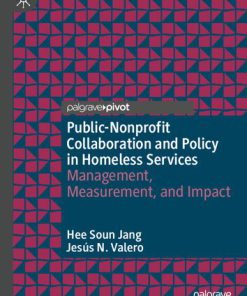Understanding and Managing Public Organizations Essential Texts for Nonprofit and Public Leadership and Management 6th Edition by Hal G. Rainey, Sergio Fernandez, Deanna Malatesta 9781119705901 1119705908
$50.00 Original price was: $50.00.$25.00Current price is: $25.00.
Understanding and Managing Public Organizations Essential Texts for Nonprofit and Public Leadership and Management 6th Edition Hal G. Rainey – Ebook Instant Download/Delivery ISBN(s): 9781119705901, 1119705908

Product details:
- ISBN 10: 1119705908
- ISBN 13: 9781119705901
- Author: Hal G. Rainey, Sergio Fernandez, Deanna Malatesta
Understanding and Managing Public Organizations
Discover the latest insights in organization theory from a comprehensive and masterful volume
Understanding and Managing Public Organizations, 6th Edition provides readers with an authoritative reference for scholars, masters, and doctoral students in public management and public affairs programs in the United States and other nations.
The 6th Edition of Understanding and Managing Public Organizations presents the latest research and insights from organization and management theory and their application to public organizations and the people in them. The book expands coverage from previous editions about organizational goals, performance and effectiveness, strategy, decision-making, structure and design, organizational change, operating environments, individuals and groups, motivation and work-related attitudes, leadership, teamwork, and more.
Authors and professors Hal Rainey, Sergio Fernandez, and Deanna Malatesta provide new and expanded coverage of such topics as
- The context and distinctive character of public and nonprofit organizations, including expanded coverage of “publicness” and of the legal context including “state action”
- Performance management, measurement, organizational effectiveness, and managing for high performance
- Representative bureaucracy, workforce diversity, and performance
- Communication and information technology
- Employee engagement and empowerment, intrinsic motivation, self-determination theory, public service motivation, and positive organizational behavior–resilience, self-efficacy, optimism, and hope
- Recent developments in theory and thought on leadership, including authentic leadership, shared leadership, servant leadership, and integrated leadership
- Design and process topics including red tape and green tape, administrative burdens, and organizational routines
- Theoretical perspectives such as behavioral theory of decision making, resource dependence theory, and others, and their implications for public and nonprofit organizations
- Advances in theory and practice about rapid developments in collaborative governance, organizational networks, partnerships, and contracting
- Since the book is used in courses for students in numerous public affairs programs, this new edition updates the Instructor’s Guide, with new and revised PowerPoint slides, cases, exercises, and discussion and examination questions
- These materials, with the topics in the chapters, are designed to address the learning outcomes required by NASPAA accreditation requirements
Belonging on the shelf of scholars and students in public affairs, as well as anyone interested in public management or organization theory, this new edition of Understanding and Managing Public Organizations provides an advanced and comprehensive enhancement to a widely used and compelling series of previous editions.
Table contents:
PART ONE: THE DYNAMIC CONTEXT OF PUBLIC ORGANIZATIONS
CHAPTER ONE: THE CHALLENGE OF EFFECTIVE PUBLIC ORGANIZATION AND MANAGEMENT
Toward Improved Understanding and Management of Public Organizations
General Management and Public Management
Ineffective Public Management?
Effective Public Management
Organizations: A Definition and a Conceptual Framework
Instructor’s Guide Resources for Chapter One
Notes
CHAPTER TWO: UNDERSTANDING THE STUDY OF ORGANIZATIONS: A HISTORICAL REVIEW
The Systems Metaphor
Classical Approaches to Understanding Organizations
Reactions, Critiques, and Subsequent Developments in Analysis of Organizations and the People in Them
More Recent Developments in Organization Theory and Research
The Role of Public and Nonprofit Organizations and Their Management in Organization Theory
Instructor’s Guide Resources for Chapter Two
CHAPTER THREE: WHAT MAKES PUBLIC ORGANIZATIONS DISTINCT
The Generic Tradition in Organization Theory
The Importance of Avoiding Oversimplification
Public Organizations: An Essential Organization/Distinction
The Meaning and Nature of Public Organizations and Public Management
Problems and Approaches in Public–Private Comparisons
Common Assertions About Public Organizations and Public Management
Instructor’s Guide Resources for Chapter Three
Note
CHAPTER FOUR: ANALYZING THE ENVIRONMENT OF PUBLIC ORGANIZATIONS
General Dimensions of Organizational Environments
Research on Environmental Variations
Recent Trends in Research on Organizational Environments
The Political and Institutional Environments of Public Organizations
Instructor’s Guide Resources for Chapter Four
CHAPTER FIVE: THE IMPACT OF POLITICAL POWER AND PUBLIC POLICY
Instructor’s Guide Resources for Chapter Five
PART TWO: KEY DIMENSIONS OF ORGANIZING AND MANAGING
CHAPTER SIX: ORGANIZATIONAL GOALS, EFFECTIVENESS, AND PERFORMANCE
General Organizational Goals
Goals of Public Organizations
Behavioral Theories of Organizational Decision Making: Changing Perspectives on Organizational Goals
Toward Diverse, Conflicting Criteria
Approaches to Organizational Effectiveness
Effectiveness in Organizational Networks
Managing for High Performance
Instructor’s Guide Resources for Chapter Six
Notes
CHAPTER SEVEN: FORMULATING AND ACHIEVING PURPOSE: POWER, DECISION MAKING, AND STRATEGY
Power and Politics Inside Organizations
Decision Making in Organizations
Strategic Management
The Miles and Snow Typology
Issues for Managers and Researchers
Instructor’s Guide Resources for Chapter Seven
CHAPTER EIGHT: ORGANIZATIONAL STRUCTURE, DESIGN, TECHNOLOGY, INFORMATION TECHNOLOGY, AND SOCIAL MEDIA
Do Public Organizations Have Distinctive Structural Characteristics?
The Development of Research on Structure
Structural Dimensions and Influences
Organizational Design
Major Design Alternatives
Organizational Structures in Public Organizations
Information Technology and Public Organizations
Social Media and Public Management
Instructor’s Guide Resources for Chapter Eight
CHAPTER NINE: UNDERSTANDING PEOPLE IN PUBLIC ORGANIZATIONS: MOTIVATION AND MOTIVATION THEORY
Motivation and Public Management
The Context of Motivation in Public Organizations
The Concept of Work Motivation
Motivation Practice and Techniques
Incentive Structures and Reward Expectancies in Public Organizations
Self-Reported Motivation Among Public Employees
Instructor’s Guide Resources for Chapter Nine
CHAPTER TEN: UNDERSTANDING PEOPLE IN PUBLIC ORGANIZATIONS: VALUES, INCENTIVES, AND WORK-RELATED ATTITUDES
Attempts to Specify Needs, Values, and Incentives
Other Important Work-Related Attitudes
Motivation-Related Variables in Public Organizations
Representative Bureaucracy: Why the Social Origins of Public Employees Matter
Workforce Diversity
The Challenge of Stimulating Motivation and Positive Work Attitudes in Public Organizations
Instructor’s Guide Resources for Chapter Ten
Note
CHAPTER ELEVEN: LEADERSHIP, MANAGERIAL ROLES, AND ORGANIZATIONAL CULTURE
Leadership Theories in Management and Organizational Behavior
The Nature of Managerial Work and Roles
Transformational Leadership
Charismatic Leadership
Leadership and Organizational Culture
Leading Cultural Development
Leadership and Management in Public Organizations
Does Context Affect Performance and Behavior?
Effective Leadership in Government
Instructor’s Guide Resources for Chapter Eleven
CHAPTER TWELVE: TEAMWORK: UNDERSTANDING COMMUNICATION AND CONFLICT IN GROUPS
Groups in Organizations
Communication in Organizations
Conflict in Organizations
Managing Groups, Communication, and Conflict in Organizations
Special Considerations for Public Organizations
Instructor’s Guide Resources for Chapter Twelve
PART THREE: STRATEGIES FOR MANAGING AND IMPROVING PUBLIC ORGANIZATIONS
CHAPTER THIRTEEN: MANAGING ORGANIZATIONAL CHANGE AND DEVELOPMENT
Relatively Natural Change: Organizational Life Cycles
Large-Scale Planned Change
Organization Development
Success and Failure in Large-Scale, Planned Organizational Change
Instructor’s Guide Resources for Chapter Thirteen
CHAPTER FOURTEEN: ADVANCING PUBLIC MANAGEMENT THROUGH COLLABORATION
Reform Movements: Forerunners to Collaborative Governance
From NPM to Collaborative Governance
The Literature on Collaboration
Instructor’s Guide Resources for Chapter Fourteen
People also search:
understanding and managing public organizations
understanding and managing public organizations 6th edition pdf
understanding and managing public organizations pdf
understanding and managing public organizations 5th edition
understanding and managing public organizations 5th edition
You may also like…
Politics & Philosophy - Government & Politics
Business & Economics - Management & Leadership
Nonprofit Management: principles and practice 6th Edition Worth
Politics & Philosophy - Social Sciences
Uncategorized
Public Finance and Public Policy 6th Edition by Jonathan Gruber ISBN 9781319105273 1319105270
Politics & Philosophy - Social Sciences
Business & Economics - Management & Leadership
Nonprofit Organizations: Theory, Management, Policy 3rd Edition Helmut K. Anheier
Business & Economics - Sales & Marketing












